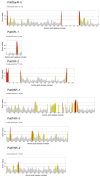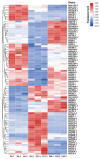Identification and Expression Analysis of G-Protein-Coupled Receptors Provide Insights into Functional and Mechanistic Responses to Herbivore-Induced Plant Volatiles of Paracarophenax alternatus
- PMID: 40565350
- PMCID: PMC12193088
- DOI: 10.3390/ijms26125890
Identification and Expression Analysis of G-Protein-Coupled Receptors Provide Insights into Functional and Mechanistic Responses to Herbivore-Induced Plant Volatiles of Paracarophenax alternatus
Abstract
Herbivore-induced plant volatiles (HIPVs) play a pivotal role in mediating tritrophic interactions between plants, herbivores, and their natural enemies. Paracarophenax alternatus, a parasitic mite targeting the egg stage of Monochamus alternatus, has emerged as a promising biocontrol agent. However, its ability to detect Pinus massoniana-derived HIPVs for host insect localization remains unclear. G-protein-coupled receptors (GPCRs) may play a role in mediating the perception of HIPVs and associated chemosensory signaling pathways in mites. In this study, a total of 85 GPCRs were identified from P. alternatus. All GPCRs exhibited conserved transmembrane domains and stage-specific expression patterns, with 21 receptors significantly upregulated in viviparous mites. Combined with two previously identified odorant receptors (ORs), six candidate chemosensory receptors were selected for molecular dynamics simulations to validate their binding stability with key volatile compounds. The results demonstrate that specific GPCRs likely facilitate HIPV detection in mites, enabling precise host localization within dynamic ecological niches. Our findings provide critical insights into the molecular basis of mite-host interactions and establish a framework for optimizing P. alternatus-based biocontrol strategies against pine wilt disease vectors.
Keywords: G-protein-coupled receptor; Monochamus alternatus; Paracarophenax alternatus; biocontrol; pine wilt disease.
Conflict of interest statement
The authors declare no competing interests.
Figures









Similar articles
-
Eco-evolutionary factors contribute to chemodiversity in aboveground and belowground cucurbit herbivore-induced plant volatiles.Plant Biol (Stuttg). 2025 Aug;27(5):847-860. doi: 10.1111/plb.13709. Epub 2024 Aug 20. Plant Biol (Stuttg). 2025. PMID: 39162182 Free PMC article.
-
Full-Length Transcriptome Sequencing of Pinus massoniana Under Simulated Monochamus alternatus Feeding Highlights bHLH Transcription Factor Involved in Defense Response.Plants (Basel). 2025 Jul 3;14(13):2038. doi: 10.3390/plants14132038. Plants (Basel). 2025. PMID: 40648048 Free PMC article.
-
Field evidence for the role of plant volatiles induced by caterpillar oral secretion in prey localization by predatory social wasps.Biol Lett. 2024 Oct;20(10):20240384. doi: 10.1098/rsbl.2024.0384. Epub 2024 Oct 2. Biol Lett. 2024. PMID: 39353566
-
Home treatment for mental health problems: a systematic review.Health Technol Assess. 2001;5(15):1-139. doi: 10.3310/hta5150. Health Technol Assess. 2001. PMID: 11532236
-
Factors that influence parents' and informal caregivers' views and practices regarding routine childhood vaccination: a qualitative evidence synthesis.Cochrane Database Syst Rev. 2021 Oct 27;10(10):CD013265. doi: 10.1002/14651858.CD013265.pub2. Cochrane Database Syst Rev. 2021. PMID: 34706066 Free PMC article.
References
-
- Yang H., Ciais P., Frappart F., Li X., Brandt M., Fensholt R., Fan L., Saatchi S., Besnard S., Deng Z. Global increase in biomass carbon stock dominated by growth of northern young forests over past decade. Nat. Geosci. 2023;16:886–892. doi: 10.1038/s41561-023-01274-4. - DOI
-
- Ryss A.Y., Kulinich O.A., Sutherland J.R. Pine wilt disease: A short review of worldwide research. For. Stud. China. 2011;13:132–138. doi: 10.1007/s11632-011-0205-8. - DOI
-
- Wu S., Gao Y., Xu X., Wang E., Lei Z. Evaluation of Stratiolaelaos scimitus and Neoseiulus barkeri for biological control of thrips on greenhouse cucumbers. Biocontrol Sci. Technol. 2014;24:1110–1121. doi: 10.1080/09583157.2014.924478. - DOI
MeSH terms
Substances
Grants and funding
LinkOut - more resources
Full Text Sources

